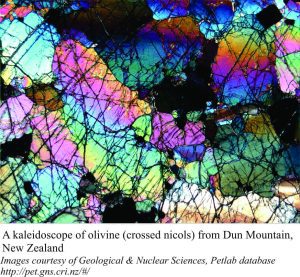This is the second in a series on the geological world under a microscope

Geologists, it seems, are never satisfied with just looking at rocks from a distance; there is some innate need to wield their pointy geological hammer. Break that rock; give it a good bash! To the uninitiated, this may seem a bit pugilistic, a kind of primal wonton destruction. But a good geo won’t hit rocks just for the hell-of it; a good Geo will be selective. Most of my field assistants and post-graduate candidates needed to be reminded of this. Find something of interest? Before you do anything else, sketch and photograph it; no one will be interested in looking at photos of rubble.
Looking ‘inside’ rocks serves a unique purpose; it allows you to travel back in time, to picture the ancient world, ancient events, outcomes of processes that involve the benign and the brutal, terrifyingly beautiful. Rocks contain memories of all these. And that is why we sometimes break them apart. The optical, or polarizing microscope allows us to unlock these rock memories in a uniquely visual way. Continue reading

